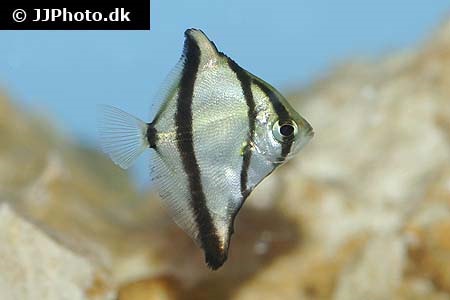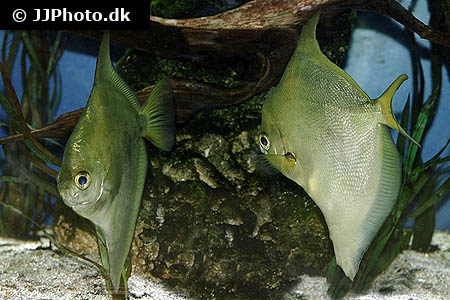Monodactylus sebae
| Latin name | Monodactylus sebae - (Cuvier, 1829) |
|---|---|
| Local name | African moony |
| Family | Monodactylidae - Monodactylus |
| Origin | West Indian Ocean |
| Max length | 25 cm (9.8") |
| Minimum volume |
800 l (211 gal) |
|---|---|
| Hardiness |
Hardy |
| Suitable for aquarium |
Suitable with care |
| Reef safe |
Reef safe with caution |
| Aggressiveness | Mostly peaceful but might be aggressive towards similar species |
| Recommended |
Larger crustaceans (Shrimp, crabs...) Macroalgea (Eg. seaweed / nori) Small crustaceans (Krill, mysis, artemia...) |
|---|---|
| Maybee |
Fish |
This spicies might be a threat to smaller fishes.
This species must be fed with an appropriately varied diet.
This species requires frequent feeding, at least a couple of times per day.
This species eats a great deal and demands an aquarium that can tolerate such a heavy load.
This species is very sensitive during transportation and acclimatizing into the aquarium.
This species will better acclimatize to the aquarium`s condition if introduced, when young.
Very small individuals can be very delicate.
This species revels in swimming and requires an aquarium with ample space.
Several specimen of this species can coexist in the same aquarium, provided they are introduced simultaneously.
This species can be bred in captivity, one can therefore consider asking your local fish store for a captive bred specimen.
Moonfish (Monodactylidae) are unique, with their special shape and that they have a reflective skin. They are seldom kept in private aquaria, but seen occasionally.
They normally live in brackish water, but can get used to water with a salinity of around 35 (specific gravity 1.026). Larger individuals do better in salt water. Adult fish don´t thrive when moved from their environment, this must be taken into account when these fish are acquired
It is important to mimic their natural environment with proper hiding places, plenty of macroalgae and tree roots.
Because they have the the tendency to swim directly into the glass when frightened, this must be avoided. i.e. dim the light gradually and permanently have a nightlight on.
| Aquarium trade | Yes |
|---|---|
| Distribution | Eastern Atlantic: west African coast, from Cape Verde to Angola (Ref. 81286), including the Canary Islands (Ref. 7314) and Senegal (Ref. 28587). |
| German common names |
Seba-Flossenblatt |
| Danish common names |
Vestafrikansk månefisk |
| English common names |
African mono |
Scott W. Michael. 2004. Angelfishes and Butterflyfishes (Reef Fishes Series Book 3) TFH Publications / Microcosm Ltd. - (English)
Bob Fenner. Marvelous Monos; the Moonfishes, Finger Fishes, family Monodactylidae - Wet Web Media - (English)
WWM Crew. FAQs about Monos or Fingerfishes, Family Monodactylidae - Wet Web Media - (English)




